The 2022 Ford F-150 Lightning isn’t a whiz-bang gadget disguised as a truck. It doesn’t promise full autonomous driving. It’s not styled like something from a sci-fi movie. No, the Lightning is a regular, everyday F-150 with an electric powertrain shoved in, and that’s pretty much it. But this no-nonsense approach is actually the Lightning’s superpower, allowing it to reach the market quickly, remain within a price range that many can afford, and appeal to the masses by being familiar and unintimidating. It’s a key factor behind why I see the launch of the 2022 Ford F-150 Lightning as a major inflection point in automotive history. The other key factor is execution, and after driving the truck last week I can say with confidence: Ford nailed it.
After having driven machines like the Rivian R1T, Tesla Model 3, Kia EV6, Hyundai Ioniq 5, and Honda E, I’ve gotten used to the “weirdness” that tends to accompany EVs. Some might also call it novelty. It’s the wacky column shifter in the Hyundai, the absurd number of electronic gadgets and storage offerings in the Rivian, it’s the Tesla’s humongous screen in an otherwise oddly understated cabin, it’s the whole vibe of the Honda E. These are some great cars I’m mentioning, here, but to most laypeople, they’re kind of weird.
The Ford F-150 Lightning is not weird. Not even a little bit.

This was not the takeaway I was expecting. When I arrived at the F-150 Lightning press event in San Antonio, I figured the truck would be quirky like every other EV I’d driven recently, but at the same time I worried that it would be severely compromised given that it’s clearly built on the same architecture as the gasoline F-150. I was wrong on both counts.
(Full Disclosure: Ford flew me from Detroit to San Antonio, put me up in a nice hotel, and fed me such high quality food that I bet I could blend it up, strain it, and use the juices as starting fluid to fire up an old Ford 300 straight six).
The first point is simple enough: Ford didn’t really weird-ify the Lightning much over the standard F-150. Sure, there’s a big-ass screen in the cabin and there’s a frunk up front — plus the whole face looks a bit different — but by and large, the Lightning is familiar. As for the second point: For years the media and consumers alike have been criticizing EVs that are based on existing gasoline vehicle platforms. “Dedicated EV platforms or bust” has been the widespread sentiment for a while now, with many believing that the compromises associated with trying to adapt a gas platform to fit EV hardware just yield a watered-down product.
I agree with this, but only if we’re talking about adapting unibody vehicles — in other words, vehicles whose structural backbones are integrated into their bodies. As for adapting a body-on-frame machine like the gas F-150 into an EV? I think the compromises are significantly reduced in number and severity, and in fact, I think they’re downright worth making at this point in time. After all, as one Ford engineer put it during lunch: “The frame is the original skateboard.”
We’ll talk about that more later; for now, I’m going to spend quite a bit of time talking about the F-150 Lightning’s hardware.
A Look At The Ford F-150 Lightning’s Hardware
The Body
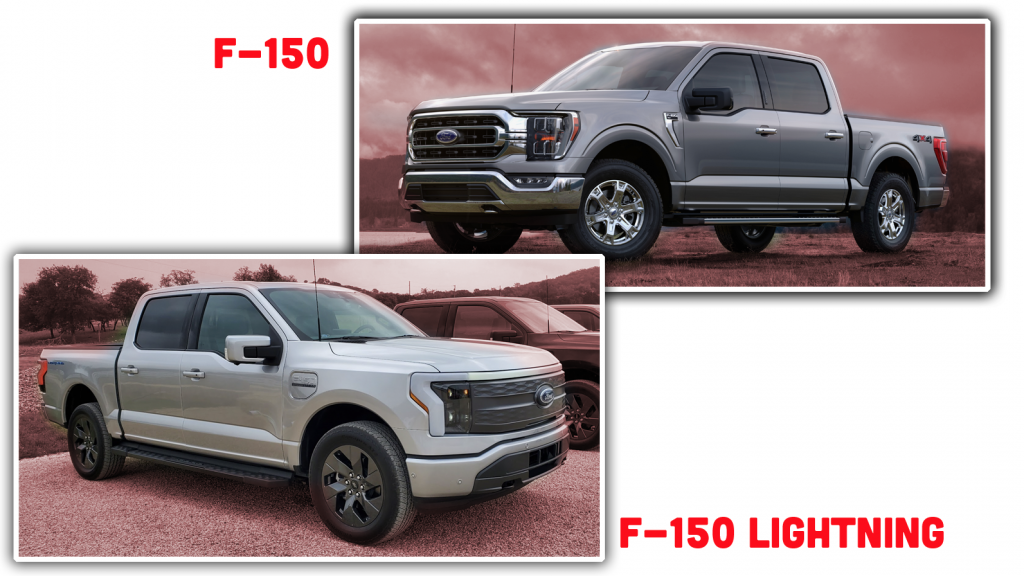
Let’s look at the F-150 Lightning’s aluminum body. Obviously, it looks remarkably similar to that of a standard gasoline F-150, and that’s because it is similar. One of the key enablers that allowed Ford to keep the Lightning’s cost down (the truck starts at around $40,000 with the standard battery and $50,000 with the extended range battery, which is dirt cheap for an EV its size), and to get the vehicle to market so quickly was component sharing. And of all shared parts between the regular F-150 and the Lightning, the biggest ones are cab, bed, and doors.
Still, despite the shared cab structure, inner box structure, and side closures, much of the Lightning’s outer sheetmetal does set itself apart from the standard truck’s. The front fenders, for example, are different; they have charging ports (okay, technically only the one on the driver’s side is real), and the gas truck’s strong arc-shaped crease above the wheel openings is gone, replaced with a large “wheel arch flat” that smoothly transitions into the fender.

The rear “box outer” panels share a similar difference: The gas truck has a sharp character line above the wheel opening, the Lightning does not; you’ll also notice that the provisions for the taillights aren’t the same, as the lights are different shapes. Plus the shape of the top of that outer box panel appears to be fairly plain on the gas truck, whereas the Lightning features a sharp horizontal line that almost gives off a “widebody” vibe. And, of course, the Lightning’s “box outer” no longer features a fuel door.
The Frunk
The Lightning’s hood and front fascia are not the same as those on the standard truck, and there are a number of other styling distinctions that Ford added to its first-ever full-size EV truck, but the main point is that the body’s main structural bits are shared between the gas F-150 and the all-electric Lightning, and that includes the hydroform rails under the hood. That’s these things:

Here’s a closer look at the passenger’s side hydroform rail:

So you get the idea: The Lightning uses a regular F-150 body, but reskins it, and as you can see in the image above, uses the void created by removing a giant internal combustion engine to create what the company calls the “Mega Power Frunk,” a storage area with an absurd 400 liter, 400 pound capacity. It’s awesome.
Ford did a nice job moving stuff out of the way to clear out all of that volume. I’ll get to the electric powertrain packaging setup in a moment, but for now, I’ll just show you some of the bits the company’s packaging engineers jammed around that frunk, behind those plastic panels that I removed, whose clips I accidentally dropped down into the dark abyss (Ford, using two-piece clips for the panels around the frunk was not the move).

For one, the 12-volt battery sits in the center, just behind the frunk, and can be accessed via the panel shown above. On the driver’s side under the plastic trim that I removed is a brake fluid reservoir, what looks like an ABS brake pump, a coolant bottle, and — hooked to that bottle — what appears to be an emergency release for the charging port,

On the passenger’s side is the windshield washer fluid bottle (whose lid pokes out through the plastic trim I removed), an AC refrigerant fill port, and what looks like a fuse box:

Just behind the frunk, right up against the firewall (you can see the indent meant for a transmission on the ICE truck) you’ll see a bunch of electrical connectors, coolant and refrigerant hoses/lines, and — on the left in the image below — a PTC heater. This is basically just a resistive heater (which works similarly to the coils on your stove) that warms up liquid coolant, which flows into a traditional heater core under your dash to warm up the cabin:
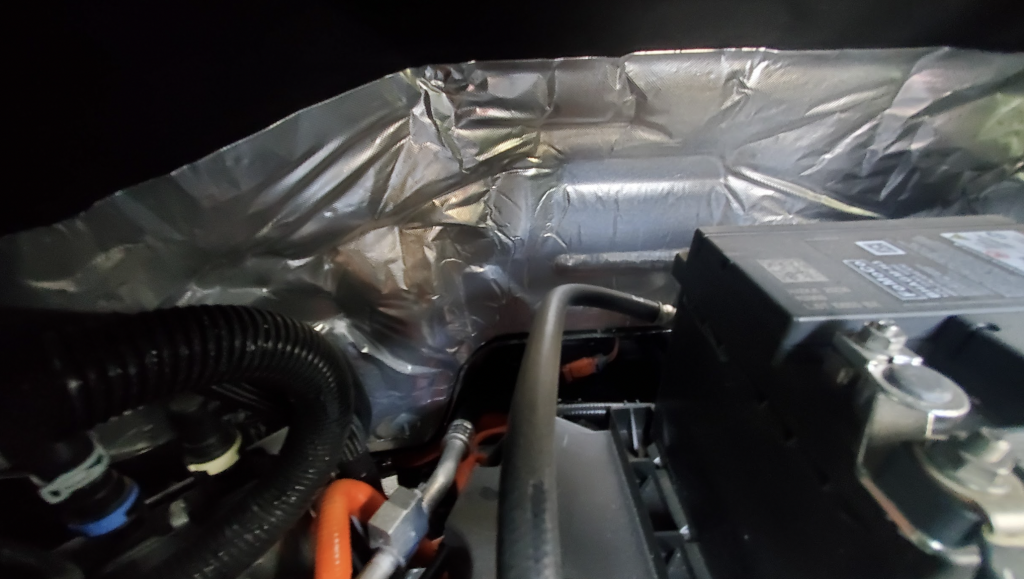
Here’s a closer look:

This is an old-school “legacy” heating setup that basically replaces an internal combustion engine (which is the typical source of cabin heat). The setup is a bit heavy and not particularly efficient compared to a heater core with resistance elements built in (eliminating the need for heavy coolant or any pumping action) and especially compared to a heat pump system, though the PTC will likely work well under extreme conditions and it’s fairly easy to adapt to the F-150’s current under-dash setup. So it’s not surprising to see it here.

The Cooling System
Also behind the frunk, as shown above, was a plate-style heat exchanger and a bunch of other hoses and pipes; I will admit that I didn’t have a chance to talk with Ford’s engineers about the Lightning’s cooling system, so I won’t discuss it much. I will say that I love what I saw in the vehicle’s lower front cooling opening:

Look at that nearly flat-mounted heat exchanger up front. It’s set up that way to allow for decent cooling capacity (the heat exchanger isn’t that small) while reducing aerodynamic drag, because instead of air flowing in and just bouncing around an aerodynamically-challenged engine bay, as is a common practice with most gas cars, the air is ejected out of the holes in the bottom of the truck. As a former cooling system engineer who hated “cooling drag” and how pressure buildup inside an engine bay tended to limit airflow to my heat exchangers, I’ve always considered the ducted cooling module my dream setup. Less drag, better airflow — what more could you want?

Anyway, enough about the body and frunk and cooling system, let’s check out the chassis.
The Frame And Suspension

The image above shows the Ford F-150 Lightning’s frame all loaded-up with its humongous 131 kWh battery, as well as powertrain and drivetrain components. Given that this frame carries the same cab and box as the gas F-150, it should be obvious that the two share body mount locations as well as a number of other dimensions , especially up front.

Ford really didn’t have much reason to change the front of the F-150’s frame, and quite a few reasons not to — the big ones being that the standard F-150 already had a suspension and steering setup that Ford believes satisfies its customers’ needs, and that the crash structure up front has already been optimized for tests like the grueling Small Overlap Rigid Barrier (SORB) assessment run by the Insurance Institute for Highway Safety. You can see that the provisions the standard F-150 has in place to pass SORB exist on the Lightning as well (pointed out with arrows two pictures down).

A Ford spokesperson told me a bit more about the commonality in the front structures between gas F-150 and Lightning, saying over email about crash optimization:
The frame in front is actually similar to the gas F-150. We have high strength steel on the side rails to compensate for the battery package. Most of the optimization was on the side, rear and mid sections. The frunk was also designed specifically with crash deliverables in mind. The team modified the front to accommodate the frunk and motors while keeping key features like SORB (small offset rigid barriers) near the front wheel location intact.

If you’re curious, here’s a look at the F-150 Lightning’s front suspension:


And here are some photos I creepily snapped of some random person’s gas F-150:


The rear part of the F-150 Lightning is where things get really interesting, because it’s a humongous departure from the gas F-150. Here’s what you’d normally find between the rear wheels of an F-150 — a solid axle:
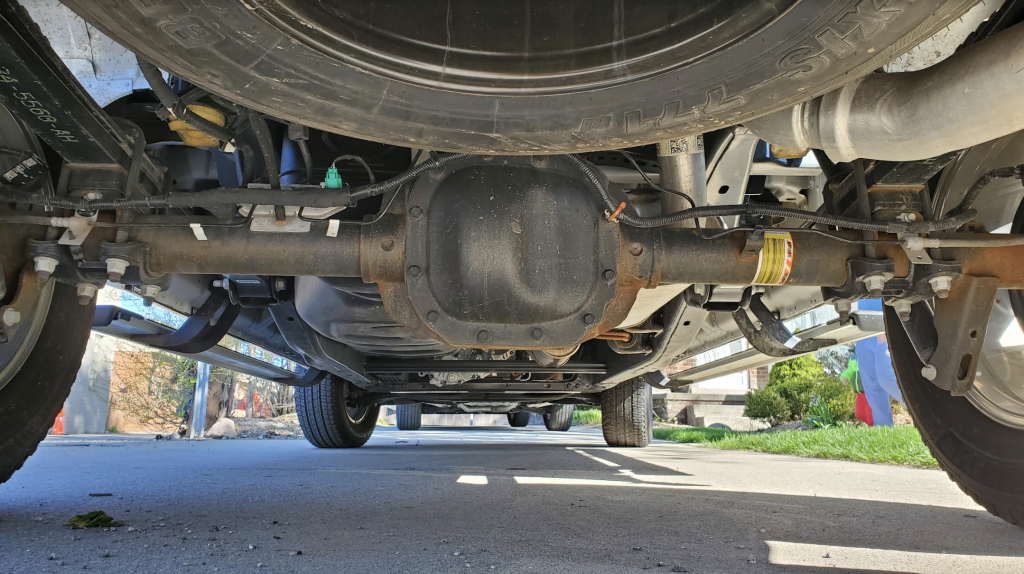
Solid axles aren’t really feasible for electric vehicles for reasons that our resident suspension engineer Huibert Mees explained in an article a few weeks back. The main factors are: Solid axles require driveshafts, which take up valuable battery space; solid axles with integrated motors are too heavy, and unsprung mass is bad for vehicle dynamics; and there are relatively significant losses associated with the power transfer in the differential of a solid axle.
So it only made sense that Ford developed a brand new independent suspension setup, and my god is it glorious. Here’s the look under the F-150 Lightning from the rear:



The axle is gone, as are the old-school leaf springs; in their places are a semi-trailing arm independent rear suspension and coilovers. Both changes are considered fairly massive improvements in terms of ride and handling — the reduced unsprung weight makes it easier to fine-tune the truck to optimize both.


The first thing you notice when looking at the rear suspension is the sheer size of the control arms; they’re unbelievable:

Look at how huge the casting is! Check out how tiny my hand looks in relation!:
This new suspension was probably a major investment on Ford’s part, but unquestionably the right call over trying to make a solid axle work.
The Battery

Let’s look at the center section of the frame — particularly the bit that holds the battery — and compare it to this center bit of the gas F-150’s frame:

One thing Ford made clear is that its team reinforced the hell out of the rails in this wheelbase-area as a way to protect the battery from side impact crashes. I believe it; the fully-boxed frame is seriously beefy.

The liquid-cooled battery pack is made up of enough pouch cells to yield 92 kWh of usable capacity in the standard-range models or 131 kWh of usable capacity in extended-range models.
The way the pack is mounted between those frame rails is quite interesting. The big battery is actually bolted to a large steel, structural ladder-shaped subframe (you’ll notice fewer crossmembers than on the gas truck, presumably because this subframe is stiffening things up), with rubber isolators between the pack and the ladder. The isolators should protect the battery from major shock loads that enter the frame; other benefits of those mounts may have to do with allowing frame flex, and there may also be NVH-related advantages involving harmonics, though I’ll update this article when I get word from Ford on its main considerations when choosing to isolate that battery. Anyway, here’s a closer look at the battery’s ladder subframe:

Here’s a closer look at how the ladder subframe mounts to the truck:

And here’s an up-close of some rubber isolators between the subframe and battery pack:

Honestly, it seems like battery removal for servicing wouldn’t be too difficult. There are some high-voltage plugs in the front shown below in orange, and there are some coolant inlet ports (in red) — and I assume the same plugs are at the back of the battery, connecting it to the rear drive unit — but otherwise it appears to be eight bolts and the battery pack (along with its subframe) are coming straight down.

[Editor’s Note: I think this easy battery removal will prove to be a very big deal as these trucks age and end up on the used market. Not requiring major surgery to swap batteries is fantastic, and I’ll be curious to see if a remanufactured/third-party F-150 Lightning battery ecosystem develops. – JT]
The Powertrain

All Ford F-150 Lightnings are all-wheel drive, at least for now. They feature the same three-phase permanent magnet AC motor at the front and rear, packaged between the frame rails and bolted to a roughly 9.65-to-one gear reduction. I say “roughly,” because, per a Ford engineer, the two gearboxes actually have slightly different gear ratios as a way to quell concerns related to harmonics. “Why even put yourself in that situation?” the engineer asked me, saying there’s no downside in having one motor run at a slightly different RPM than the other; this can make a difference in ensuring that the two motors don’t constructively interfere and create a Noise, Vibration, Harshness issue. (Incidentally, that same engineer told me that, during highway cruising, Ford found that running a 50/50 torque split between front and rear motors was most advantageous).
Here’s a look at those motors’ guts:


Here’s the motor controller that’s integrated into each drive unit. Its job is to make sure the motor does what the driver tells it to do (accelerate, regen, go in reverse, etc):

The gearboxes, by the way, are axial/planetary types, meaning the motor is parallel to the output shafts (one axle goes through the center of the motor). That’s why you can see that both motors are right in line with the axles (Teslas tend to have the motors offset with the gearbox output, so the Motor is either in front of or behind the axle).
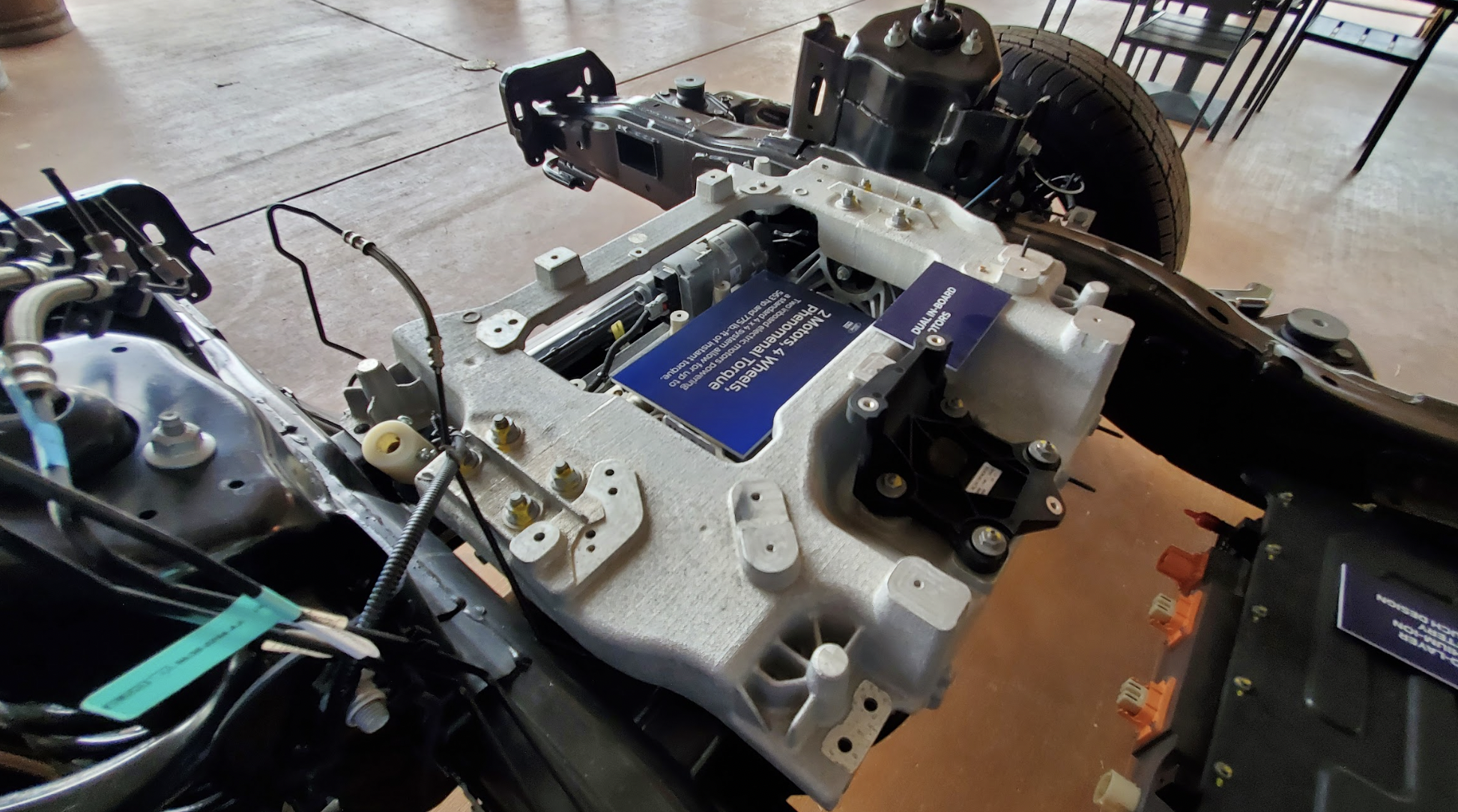
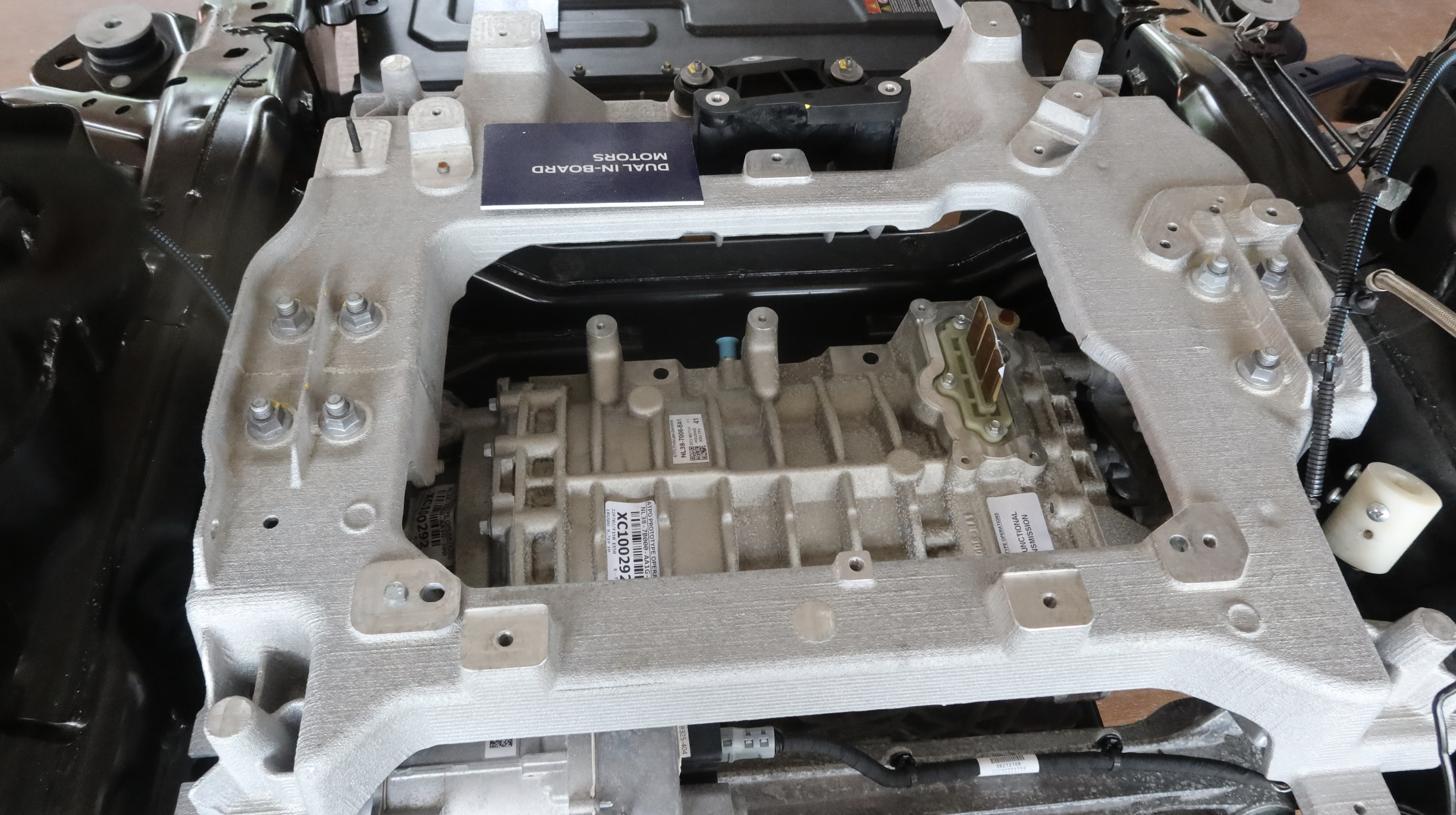
Let’s have a quick look at that front motor. It hangs from a cast aluminum bracket that’s bolted to the frame. It has a bunch of provisions for, presumably, an inverter and power electronics, and you can see that in the rear there’s a black bracket for one of two high-voltage AC compressors (Ford says it uses two to feed chillers for optimal thermal performance in high-load, high ambient temperature situations).
Here’s a closer look at how that front drive unit hangs off that cast aluminum subframe — you can see round rubber mounts:
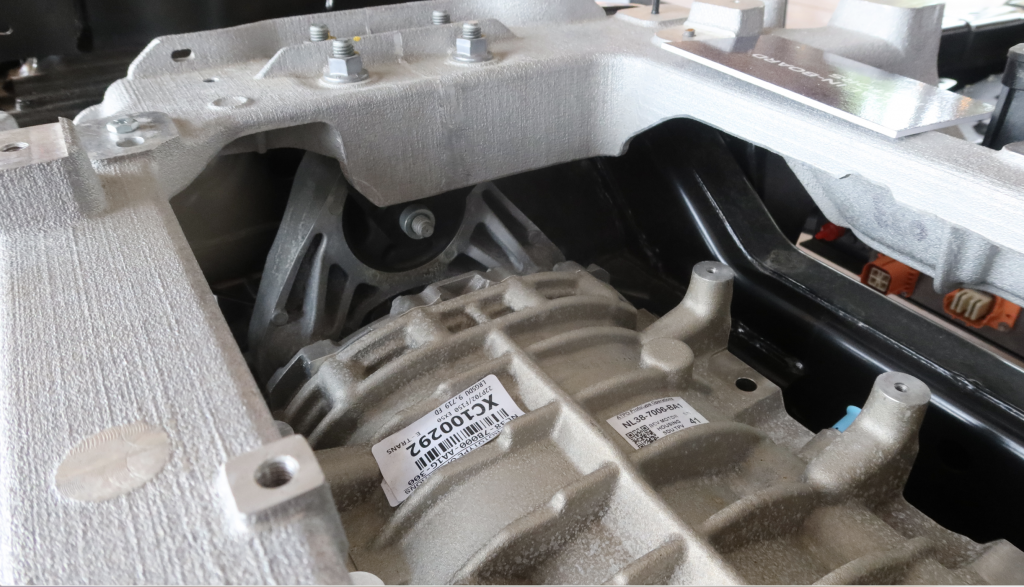

Of course, with just two mounts, as soon as you’d hit the accelerator pedal, that motor would just spin about its axis, so here are the two additional torque mounts. They’re two dogbone-shaped links that tie the drive unit to a front frame crossmember (which is different from the gas truck!), which is also where one of the front suspension control arm mounts ties into (also: notice the plate-style heat exchanger on the drive unit):

While we’re on the topic of crossmembers, it’s clear that Ford is making the most of them. The rear drive unit also shares a mounting location with the humongous control arms. Here’s a look at the rear drive unit, which you can see clearly along the same axis as the rear wheels:

Here’s a zoomed-out view of that shared crossmember, which I’m going to now dub the Mega Power Crossmember:

Here are the motor mounts. up close:
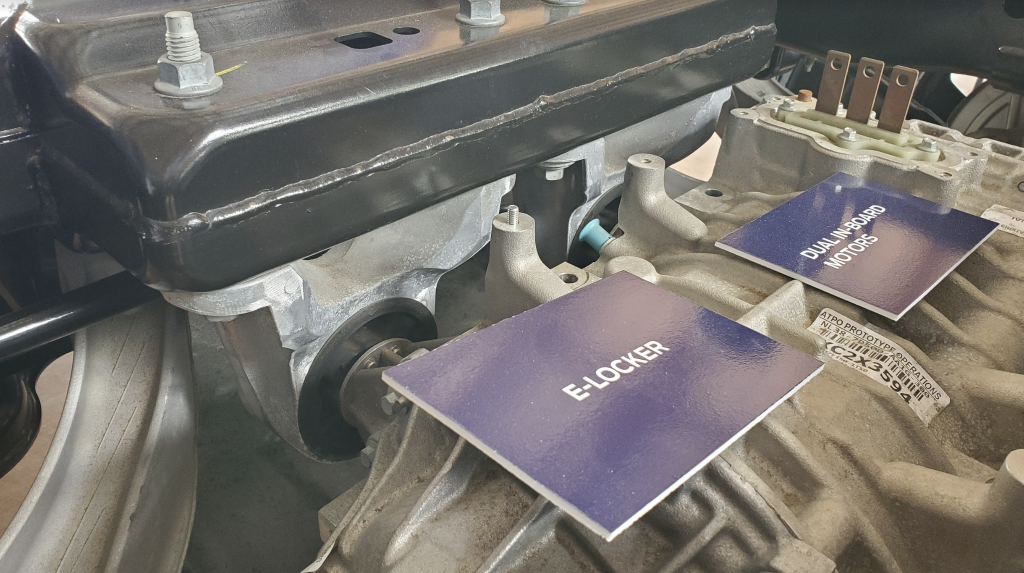
And here you can see where those massive control arms tie into that same crossmember (and like on the front drive unit, you can see a plate style heat exchange bolted onto the rear unit):


The rear motor has two additional mounts — at the two brackets that point straight down from the frame on either side of the spare tire:
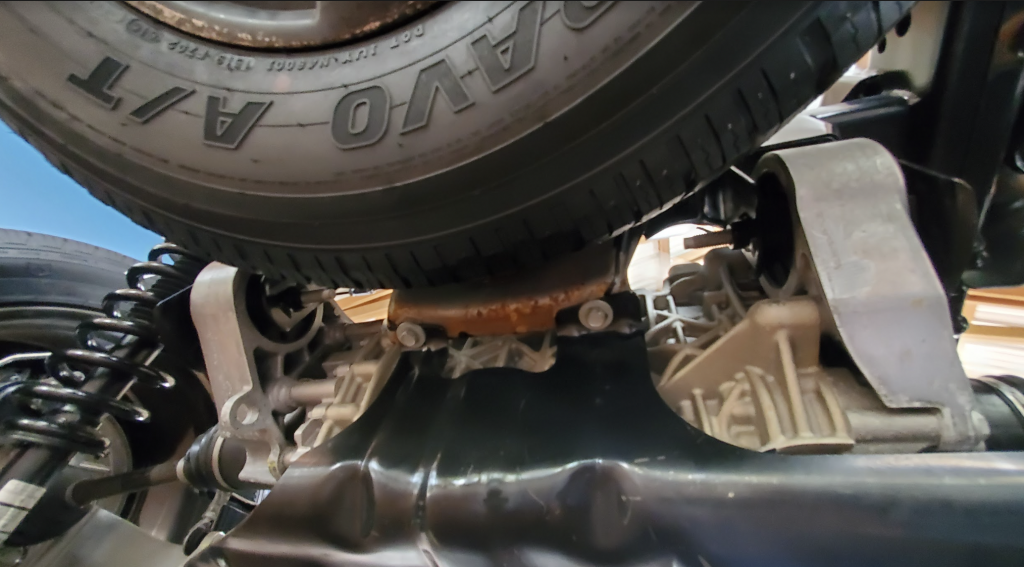


Anyway, I could spend another 5 million days writing about this truck’s hardware, so I’ll stop and ask you to watch the video below so I can get to the subjective stuff.
What’s It Like To Drive?
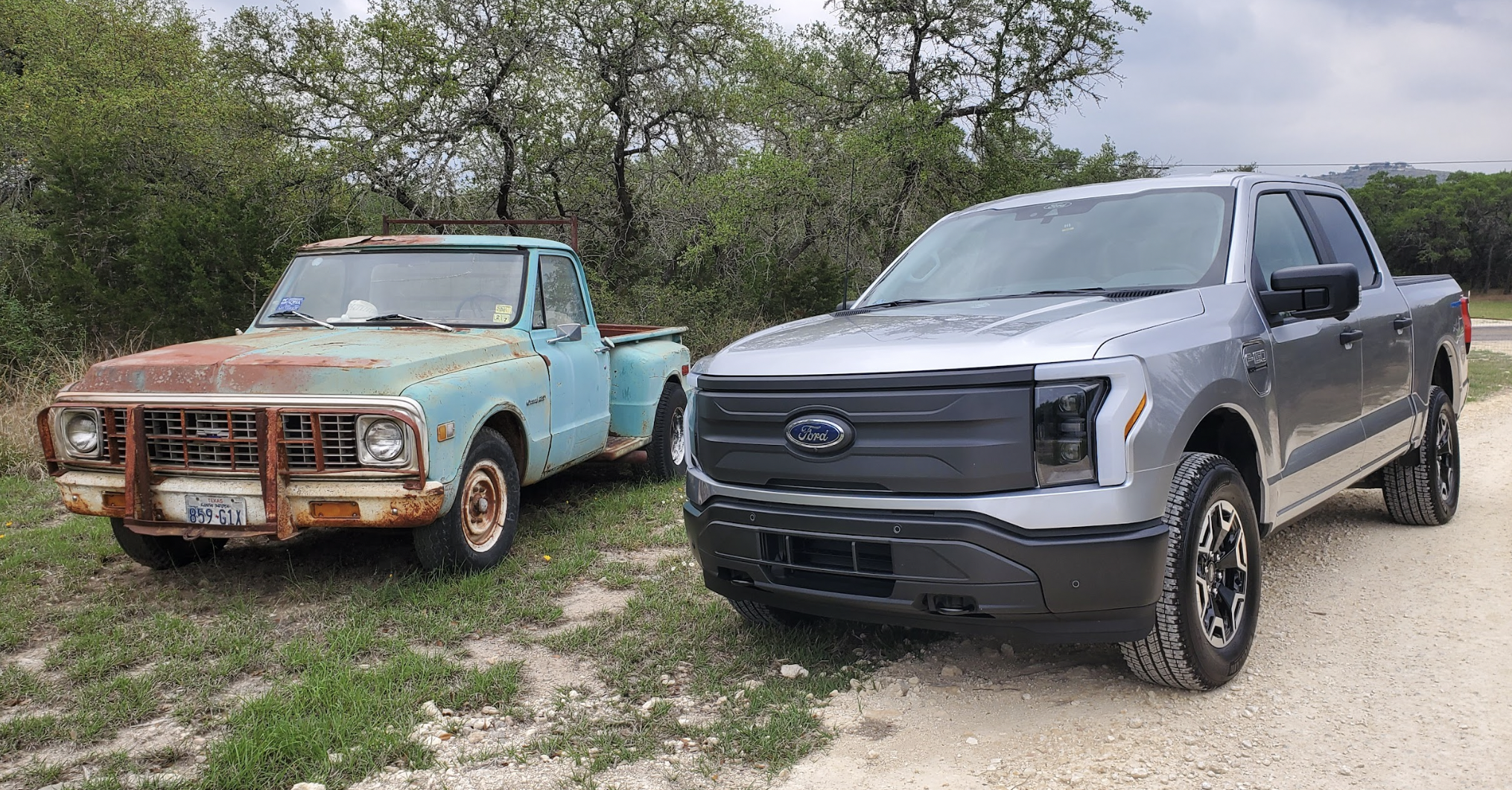
The first F-150 Lightning I drove was a $56,100 base “Pro” model with the extended range battery that promises 320 miles of range (the smaller pack offers 230, per the EPA). This is a fairly basic truck, with vinyl floors, synthetic leather seats, and an interior devoid of too many frills.
The Cabin Looks Familiar, Sounds Anything But

Everything about the cabin feels like a regular F-150, and that’s because the Lightning shares the gas truck’s interior; it even shares bits you wouldn’t expect it to share, like the chunky T-handle shifter, which is a far cry from the dainty “shifters” one tends to find in other electric vehicles.
Ford’s parts sharing, especially here in the interior, is a brilliant strategy, and not just for the obvious “It saves cost” reason, but because it offers truck buyers familiarity. The reality is that there’s still a bit of a hump that traditional pickup truck customers need to get over before they’re fully onboard the electruck train; to offer them a vehicle that looks and feels like an F-150, but introduces the many benefits of an electric powertrain is a great way to transition the masses to the new technology without shocking them with too much gadgetry.
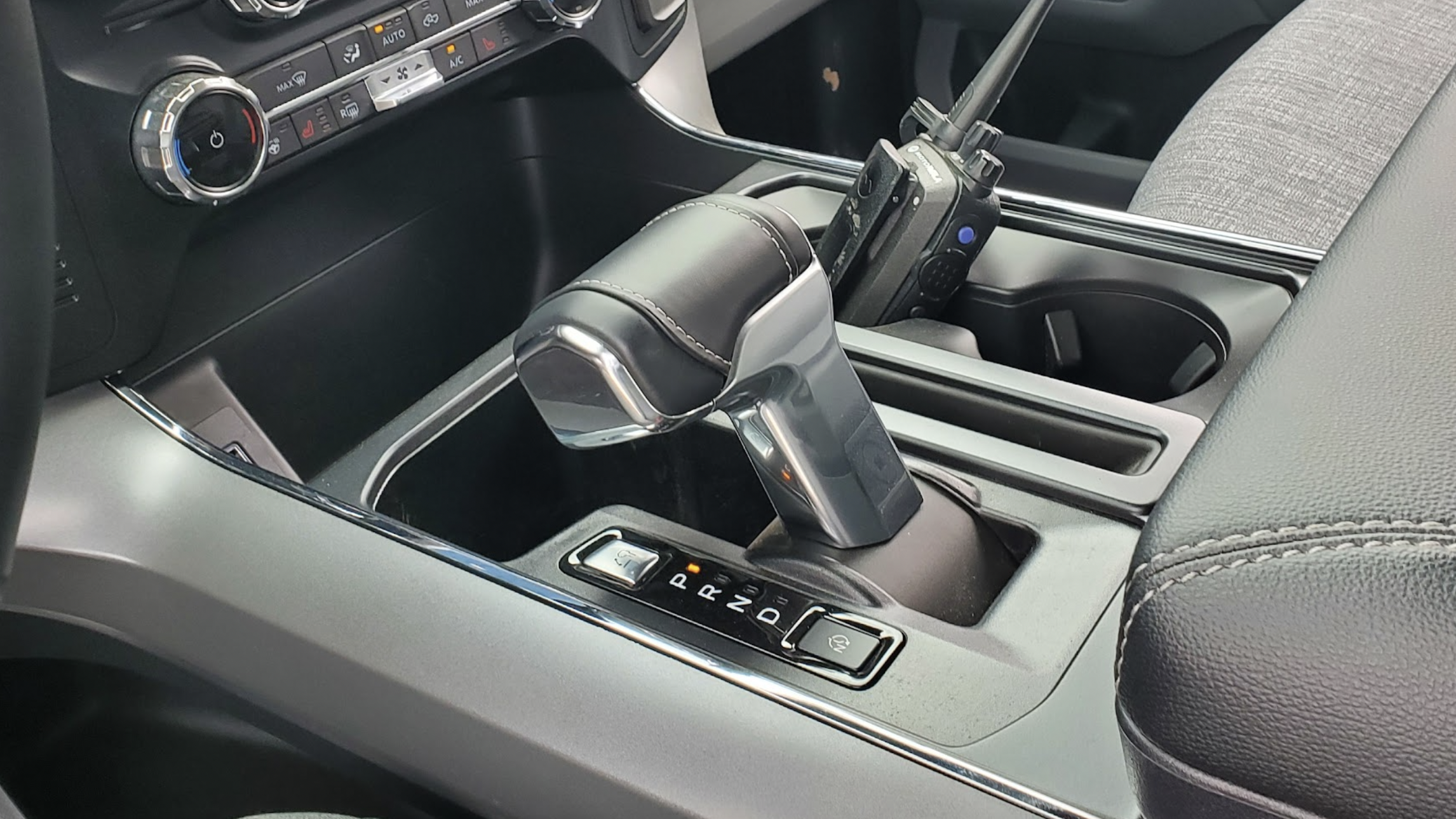
The F-150 offers truck buyers the chance to head to a dealership and drive a gas and electric version of essentially the same truck, so they can really see the differences that EV technology offers in terms of performance. And that, I think, is going to go a long way to convincing truck buyers that EVs are worth their money.

Hopping into the truck, I clicked the “start” button, and shoved that satisfying shifter into “D,” before pressing the accelerator pedal and quietly inching the big, heavy pickup through downtown San Antonio towards the freeway. When I got there, one thing became abundantly clear: The Ford F-150 Lightning may be the quietest vehicle I’ve ever driven. It is absurd how well-isolated that cabin is from tire noise, wind noise, neighboring car-serpentine-belt-squeal noise, you name it — the inside of the truck is a borderline sensory deprivation chamber, with aero noises only making themselves even worth noticing at speeds above 70 MPH, and road noise really the only noticeable audio signal to your brain during most driving.
My lack of sleep the night before, combined with the quiet cabin, led me to pull over and actually go to sleep in the middle of my test drive. Which I’ll remind you, is my job. The F-150 Lightning forced me to sleep on the job. My reputation is in jeopardy.

Lariat and Platinum models get a Lightning-Exclusive 15.5-inch infotainment screen and some other changes to the interior, so for those of you not interested in those vinyl seats and floors, here’s a nice dashboard to go along with your fancy Latte:

On the fancier trucks, you can also get “BlueCruise,” a feature that allows for hands-free driving, though you have to be ready to take over. I’m not a huge fan, since I think I may as well hold the wheel if I might have to jump in any moment anyway, but — despite a few hiccups — I will say that the system allowed me to drive on a nicely-marked freeway for roughly 15 minutes without me having to provide input. Perhaps over time I’d have appreciated that.
Acceleration, Ride and Handling
The Ford F-150 Lightning that I drove makes 580 horsepower and nearly 800 lb-ft of torque. The thing, as shown in the video above, is an absolute slingshot, with full-pedal applications forcing my head hard against the headrest as the vehicle rocketed to 60 mph in not much more than four seconds. Like most EVs, the Lightning responds to input with immediate and unrelenting fury beyond what most have probably ever experienced in any pickup truck. Dodge Ram SRT-10 be damned.
The Lightning’s ride quality is great. The suspension never feels jittery or harsh; it’s confident and stable. I can’t tell you how much better the ride is compared to the solid axle-and-leaf spring-equipped gas truck because I daily-drive old junkers, so my butt-sensors are all sorts of out of whack. (I find the gas F-150 to ride beautifully, too). Still, there was no head-toss where I might have expected it on the solid-axle truck, particularly when hitting bumps in turns.
Speaking of the turns, I did not approach any at speeds that I’d consider even remotely “high” (hell, or even “moderate”). Despite its near-50:50 weight distribution, this is a pickup truck, not a sports car, and I’m not trying to die. Is this truck heavy at over 6,500 pounds? Yes. Could I feel that in the turns? Sure. But lots of trucks are heavy, and I found the Lightning’s handling to be just fine, with the truck having some body roll, but less than I expected.
It Tows Like A Boss, But Prepare For Torque Steer

A number of you likely want to know what the F-150 is like when it comes to towing and especially towing range. And while I can’t answer those fully, I did have a chance to tow a 4,500 pound airstream for about a half an hour, and I took a peek at a bunch of different trucks to see how much range they expected when hooked up to certain trailers.
First, I’ll discuss towing performance. The truck above handled that Airstream like an absolute boss. I’ve done a lot of towing in my life, usually involving broken cars on U-Hauls, and no towing that I’ve ever done was remotely similar to what I experienced in the Lightning. Usually when you’ve got 4,500 pounds hooked to your hitch, you adjust your driving style. If you merge onto a highway, you might look especially far back in that side mirror to make sure nobody’s within’ at least two counties of what will be a glacially slow acceleration to highway speeds.
But in the Lightning, that’s just not an issue. The output of those motors is so prodigious that, even with a trailer hooked up, stomping on the accelerator pedal yielded instant, and downright impressive acceleration. I think the truck, even with a 4,500 pound trailer, could do zero to 60 mph in under seven seconds. That’s just a guess I pulled out of thin air, but the mere fact that I’m predicting anything below 10 seconds should tell you how absurdly responsive the truck is while towing.
[Editor’s Note: I’d like to point out that the dash display in this video is interestingly minimal; David told me it’s a special “calm” mode, perfect if you’re someone who hates overstimulation. Personally, I like my display to look like the bridge of a spaceship, but I get the appeal. – JT]
One thing I should mention is torque steer — the tendency of a vehicle to turn on its own under acceleration. On the Lightning, particularly when loaded up and when the driver is heavy on the pedal, torque steer is pronounced. While towing, if I stomped on the pedal, the wheel would want to jerk counter-clockwise. Keen to avoid the oncoming lane, I naturally made a steering correction, which led the traction control system to send power to the opposite wheel, leading me to again make a correction, which sent power to the other wheel on the front axle, and on and on.
Too much pedal would sometimes got me into a cycle where the truck would lose grip on one front wheel, torque-steer, I would correct, power would transfer to the other side, which would lose grip, I’d get more torque steer and make more corrections, and the whole thing was just bizarre — I’m hacking away at this wheel as the truck is chirping the left tire, then the right, then the left, then the right.
Obviously, heavy throttle while towing is a fairly narrow use case, but I noticed the issue even while accelerating out of turns — one tire would chirp, torque steer would join the party, I’d try to boot torque steer out of the front door, and then it’d just come right back in the back door, and it was all just a bit odd.
Also relevant when towing is the tow-vehicle’s weight. A fully-loaded F-150 Lightning comes in at around 7,000 pounds. And while this isn’t ideal for handling and efficiency, it could be advantageous in terms of towing stability. I haven’t spent enough time towing with the Lightning or the gas truck, but I will say that yanking the trailer with the Lightning was one of the least stressful towing experiences of my life, and I was on twisty, unfamiliar roads. (Well, I should say: unless I pressed the pedal too hard).
Towing Range

[Editor’s Note: David says the “How To Talk To Girls” was a song, not a self-help audiobook, and it was on the truck and he didn’t pick it so no judgments. – JT]
Let’s talk about range.
At the media event, a Ford engineer told journalists that he found that “the impact [of towing] on range in an electric vehicle is basically the same as the impact on range in a gas vehicle.” So if you’re used to 22 MPG highway on your unladen F-150, and you typically get 11 MPG highway while towing a given trailer, you might expect to lose about 50 percent of your range when towing that trailer on an F-150 Lightning.
Obviously, this is possibly the least scientific answer to the towing range question, but I appreciate Ford even providing a general guess, since there are so many factors that play into towing range, including trailer shape, trailer size, ambient conditions, driving style, etc.
Keen to see if I can get another indication of how many miles one might expect from the battery while towing, I looked inside a bunch of trucks that were towing loads to see what the indicated expected range was.

The way the F-150 Lightning predicts towing range involves making an initial guess based on inputs from the user — things like dimensions of the trailer, trailer shape, and trailer weight. After that initial guess, the truck refines its range estimate based on driving history. The trucks at the press event had been driven on the same route numerous times, so they should have had a chance to make reasonable range estimates. So let’s look at a few readouts starting with the one above in my tow truck.
My truck, with its 4,500 pound trailer, estimated a remaining range of 144 miles based on a 93 percent battery capacity. Assuming a linear relationship between range and battery percentage (which is fine for a back-of-napkin calc like this one), my truck should manage 155 miles of range, or just about half of the unladen range.

The truck above towing the 5,000 pound horse trailer showed an estimated range of 138 miles, with a remaining battery percentage of 87 percent, equating to a range of about 160 miles.
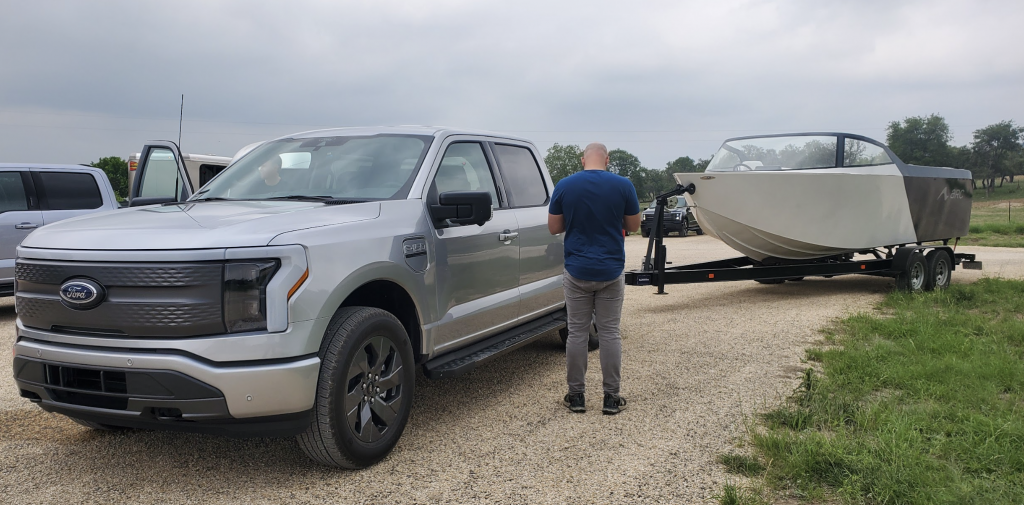
The less-boxy boat above weighs 8,300 pounds, and the truck’s screen said it had 135 miles left based on 88 percent battery state of charge. So at full battery capacity, the truck should go 153 miles.

The truck above towing a 5,000 pound horse trailer said on its screen that at 81 percent, its battery could get the truck 128 miles. That’s about 158 miles if the battery were full.

The truck carrying the heaviest load is this black one. It showed 61 percent battery capacity remaining with an estimated range of 90 miles. Ninety miles divided by 0.61 is about 148 miles. Note that the truck showed an efficiency of 1.1 miles per kWh.

I want to make it clear that these are just estimates, and that none of these trucks were driving at highway speeds, plus I don’t really know how much driving data the trucks had to base these figures off of, but in a world where people seem endlessly curious about how well and how far electric vehicles can tow, I figured this would be better than nothing. I’ve included Ford’s claimed charging times above, so you can get an idea of how long it’d take to get another 150-or-so miles out of your tow rig.
Off-Road
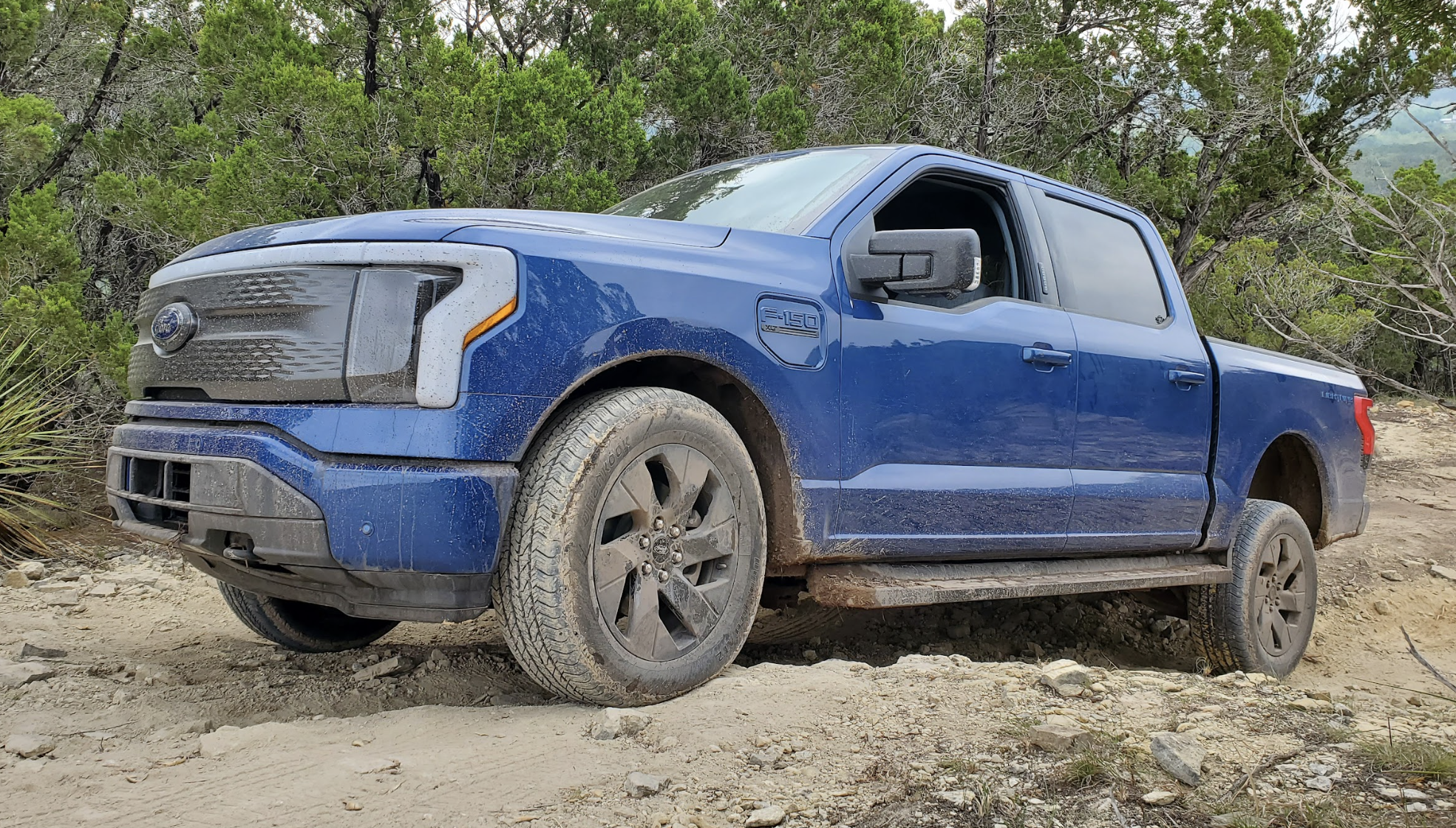
The Ford F-150 Lightning is not an off-road vehicle, but it is a pickup truck, and with that classification come certain expectations.
I took the Lightning off-road on a fairly mild course in San Antonio, and had a chance to climb up some hills and bomb through some mud pits. The truck did very well. The standard locking rear differential — activated with a press of a button on the touchscreen — mechanically connects the two rear tires together, and provides a significant traction advantage. Up front is an open differential, though a brake-based traction control system (often called a Brake Lock Differential) does a decent job apportioning power to the wheel with grip.

Obviously, with the solid rear axle gone, overall suspension flex is down over the gas truck, but honestly, the rear suspension travel is not insignificant:



When one tire does lift off, you’ll be glad you have that rear locker to make sure power gets to the ground. 
I have to give some credit to whoever did the pedal calibration for the truck. When in off-road mode (which you select on the touchscreen), I found it easy to precisely modulate the truck’s speed when climbing steep grades. In many trucks, I tend to surge over the tops of hills, or I have to keep my foot on the brake pedal to keep speeds down, but with the F-150 Lightning, I could climb grades incredibly slowly while having only my right foot on a pedal.
In lower load scenarios (i.e. not climbing steep grades, maybe going over a log), I found that it was a little harder to modulate speed. The truck tended to want to go faster than I wanted, so I did find myself using left-foot braking. This is an instance where I’d have liked at least the option of one-pedal drive mode, which is only available outside of the off-road drive mode. One-pedal drive basically slows the vehicle to a stop unless the driver is on the accelerator pedal, so it’d help in scenarios where one wants to avoid gaining too much speed, such as when traveling downhill.

In fact, there is no hill descent control at all on the Lightning — you just have to ride the brake. This isn’t a huge deal, since the brake pedal “blends” regenerative braking with friction braking, but it’d still be a bit nicer to have the machine keep you under control so that it’s not just your right foot preventing you from careening down a hill at 30 mph. It’s a little unnerving, especially as someone with lots of off-road experience who’s used to using low-range gearing and engine braking to keep speeds under control.
Ford did offer an explanation for the lack of one-pedal driving in off-road mode: Basically, one-pedal driving mode pretty much sacrifices some amount of pedal travel — say, 20 percent. So if you’re not pressing the pedal 20 percent, you’re decelerating. “That means you’ve taken away 20 percent of your pedal travel from your acceleration ranges, so that’s less fidelity that we can give you for power application.”
Hmm.
In either case, on a vehicle like the Lightning, which really isn’t meant for hard-core off-roading, I think Ford made some smart decisions, as the vehicle is capable enough despite its geometry, which is rather limiting.

The ground clearance wasn’t too bad, but that low-slung battery, along with the long wheelbase, meant that battery subframe rubbed while I was off-road. I anticipate breakover angle being the biggest limitations to the truck’s capabilities, which again, are more than adequate.
Update: One thing I forgot to mention was that I heard quite a bit of “clicking” while off-road, especially in low-traction situations like the mud pit. The clicking was unlike anything I’d heard from any conventional ABS pump, so I wasn’t sure what was going on. It sounded like relays. Well, a friend of mine reached out and mentioned the brake parts I showed in my underhood photos, saying he sees a “one box” braking system with combined booster, master cylinder, and ABS controller (this single system decides how to decelerate the truck by choosing how to blend regen and hydraulic braking). “If you’re on ice you’ll be able to hear all the clicks and clacks,” he told me of such a setup. And that reminded me of the clicks and clacks I heard in that mudpit. Anyway, the point is: You hear braking clicks while off-roading the Lightning. It’s no big deal.
Conclusion

I mentioned in my introduction that electric cars built on gasoline platforms tend to be highly compromised machines. Vehicles like the VW e-Golf and the electric Mini come to mind. These cars are built on unibody platforms that, by their very nature, are shaped in a precise way that optimizes packaging efficiency for a gas vehicle. The unibodies not only integrate the vehicle’s structure, but they also envelop major components like the gas tank, exhaust, and driveshafts. The bodies are literally purpose-designed for gasoline powertrains.
Fitting a big flat battery pack under the decidedly-not-flat body of a car specifically built with provisions for ICE components just doesn’t work well.; The vehicles tend to fit too few batteries, or those batteries are in a weird location, and the end product tends to weigh too much (since the battery wasn’t integrated into the body’s structure in the first place).
Things are different with a body-on-frame machine. If you look at how a truck is built at a plant, you’ll see that the frame acts sort of like a Tesla “skateboard” in that it contains the suspension, and the main drivetrain and powertrain components are mounted to it. A body sits on top.

A body-on-frame setup lends itself well to electrification, since there’s so much space between the rails. Unibody proponents have said that this is wasted space, and part of the reason why body-on-frame vehicles tend to have taller floors and less interior volume, but for the purpose of electrification, this “wasted space” is actually quite welcome. Ford was able to clear out enough stuff from between its frame rails to fit a humongous battery, as well as a complete, high-performance electric drivetrain — all with zero compromises to interior volume. In fact, the frunk actually increases overall volume.

Of course, there are compromises associated with going this route. Mounting a 1,600 pound battery on a heavy ladder frame, and not using the battery as part of the vehicle’s structure doesn’t seem like the best way to keep weight down, and if I had to guess, the truck could have been better optimized for aerodynamics had it not used the same cab as the gas truck.
Speaking of integrating the battery, I think a ground-up new platform likely would have tucked that thing up a bit. As it sits, the battery hangs down below the rockers in a way that’s not particularly aesthetically pleasing, adding a bit of bulk to the side profile:

Side steps help with that:

Anyway, I mention all of this because engineering is literally the art of compromising. And when I look at the Ford F-150 Lightning, all I can see is brilliant engineering from a company that can’t seem to miss right now. The few compromises I just mentioned were clearly, without question, the right ones to make in order to share enough components to allow Ford to build the first mainstream full-size electric truck in U.S. history quickly, in a price range that appeals to consumers, and in a way that should maximize quality (since many of the components have already been vetted) — and also to execute it all well. And Ford has. This truck is quick, it rides great, its EPA-rated range is solid, it’s unbelievably quiet, and above all — it’s familiar.
And that last point, as I’ve said before, has the potential to shift America towards electrification like no vehicle ever has.









@RootWyrm: you make some really interesting points. IMHO if they had made a plug-in hybrid, with a 6-cyl full-Atkinson-cycle high compression engine, say 180 KW, like in Toyota highlander hybrid, and say 32 KWH battery and two 125 KW electric motors. RWD is electric so no differential or xfer case clearance issues.. I could imagine a full-size pickup 30+ mpg but spacious INSIDE, but not ridiculously massive-instead sensible hometown America apple-pie simple aerodynamics like 10th-gen Y2K F-150s had, you could make an affordable, 30+ mpg full-size 4 door truck that could haul 6000 lbs. Would weigh less, better ground clearance, independent suspension like RAM already has.. cost you $5K more: Batteries&motor cost you, but than base model F-150 smaller engine&radiator & gas tank means lighter frame, etc. At idle engine stops but A/C keeps running. no more wasted idling. FORD could have done it, but they didn’t
@gettstoney: It was a neat review, but the reviewer didn’t check the range, the most important single thing to understand. He said he pulled over and fell asleep, which was funny i admit, but then- no data.
Ford claims 320 miles from 96 KWH usable. That is really good. even with charger efficiiency that’s 320 miles from about 125 KWH, which is a clauim of 0.4KWH/mile, which is almost as good as a sleek Tesla model S, but this thing has a Cd of about 0.45? and a frontal area of say 6m^3 so it has ~2.5x the air drag and about ~2x the mass of a Tesla model S. I doubt they get better than 0.6 KWh/mile on the highway; city I’d bet 0.5 KWH/mile unless they baby the hell out of it, And in winter range will be 10%-20% less depending on Ford’s design choices. I think Ford was obfuscating with all that towing mileage hoopla. Why didn’t they just drive the Truck with a full charge on the highway till it was out; recharge it and do the same for city driving?
I liked the review, and the lack of “EV gimmicks”, but (i) Ford hid the range or didn’t let the reviewer test it, or blew smoke about it with towing stuff and hyping the chassis features; (ii) Ford is playing stupid pricing games and charging people $$$$ WAY too much for basics; (iii) IMHO, a plug in hybrid like 32 KWH batttery and Atkinson-cycle 6-cyl , would be $1000s cheaper, more versatile, nearly as efficient, and have better range, especially in winter; (iv) the torque steer would be hell in winter, and the ground clearance of 8″ is like a RAV4. we’ll see. Hopefully i’m wrong.
On the trailer hauling . . . that boat shown hooked up to one of the trucks weighed 4 TONS (8400 lbs)? For real or is that a typo?
It was an electric boat and that included the trailer. Not a typo.
I think this is the perfect time for some vehicle manufacturer to design, build and sell a CAB-FORWARD pickup (and van), make them electric like the Lightning. A short nose/frunk in the front can give you the necessary occupant protection in the event of a front collision, and the battery pack between the rails in the back offsets the front end weight bias that a cab-forward design normally has. A cab-forward design design also gives you a larger cargo area for a given wheelbase, over a conventional pickup.
By the way, GREAT article and photos, David!
David,
As a mechanical engineer at a midwestern luxury appliance manufacturer, I am disappointed to see most (if not all who are not in the industry) make the mistake of calling a “range” a “stove.” A device that have tubular heating elements on its top as you described is a range (or a rangetop if it does not have an oven underneath it, or a cooktop if it just drops into a hole in a countertop. The last is also referred to as a “hob” in some parts of the world). A stove uses a chamber under the cooktop to generate heat. Think of an old wood, or coal, fired stove that you would place cookware on. Where a range would have an oven, the stove has the chamber for the heat source for the cooking surface.
Also, if you think the control arm castings on this truck are huge, I’ll point you to the some of the world’s largest trailing arm castings on a truck – about 20 tons each. This truck is a bit bigger, hauling about 330 tons, and originally made in Euclid, OH. This would be from a former employer of ‘mine.’ That should give you enough hints. I’m not sure if they still cast them or if they’ve redesigned them as fabricated items these days, but the ones made about 20 years ago were definitely cast.
That Frunk is huge. 400lb capacity.
Am I the only one who’s curious about how different types of Frunk cargo will affect front end crash safety ratings. Say I’ve got an antique sword collection I need to transport?
Nice, these fencing T Posts fit in the Frunk (Directly in front of the passenger seat firewall parallel to the direction of travel). What could go wrong.
You want more range? You gotta give up the traditional pickup look. Sorry, it won’t look like every other of the 5 million F150’s on the road.
David,
Awesome review. Accurate take on EV weirdness as well. Thanks!
David, thanks for the great review. And you nailed what makes this so important: for electric vehicles to really gain traction, you don’t have to sell a futuristic dream to the forward-thinking early adopters, you have to sell to everyone else. And this will do that if they can make enough of them.
The other thing worth considering is the sheer volume of vehicles that the F150 will sell every year could make a healthy aftermarket for these trucks a viable business proposition.
Amazing review, fantastic truck. I’m curious if they might be able to improve some of the torque steer weirdness with firmware updates. With everything being electronically controlled and synchronized it seems like there would be plenty of room to adjust and improve without changing any hardware.
David: I had 1forgotten that your engineering specialty was in vehicle cooling. That completely explains why you use your Jeep’s bed for grocery storage and cooling. I for one would be happy to have a tailgate breakfast and chat if the opportunity ever presented itself.
This thing would have been PERFECT for my dad’s contracting business. Load the frunk full of tools, and have the bed wide open for building materials. Tow the boat to the local lake on the weekends. He’s semi-retired now, installing servicing Generac built-in standby generators out of the back of a Tahoe. Actually, it would be pretty perfect for that too.
Great review!
The decision to make it as much like the regular F-150 is a smart one, but whether it’s electric, gas or diesel powered, I hate console shifters in trucks. Slap that thing on the column and get it out of my way.
It’s funny because every truck comes with a button to fold that shifter down. Not all of them have the center console desk optioned but that fold feature is on all of them.
Most excellent review, especially the (relatively) deep dive into the engineering.
A few comments:
How close is swing arm front mount point to front leaf spring mount point? It looks like the swing arms are about half the length of the leaf spring.
Is it a correct assumption that the towing-range figures you showed were all from the larger battery pack?
In the picture where “the battery hangs down below the rockers,” most of what you are seeing there is frame, with just the bottom 1″ or so the battery frame. It would have been worth a pic of a gas F150 of the same trim level for comparison.
Yeah, the frame rail on my hybrid F-150 hangs down pretty low from the start of the second door of the crew cab.
Awesome review, and I’m genuinely interested in this truck but the towing. The loss of range really kills it for me. Everytime I tow it’s hundreds of miles and non stop as well. My excursion effortlessly pulls well over it’s maximum and with decent mileage ( sometimes I gain mpg depending on load) all with a gas engine. I’m 300miles + towing a load in between fillups which makes things alot nicer. I couldn’t imagine stopping and having to find a charger. Even on daily use if I need to goto town, come back then hook up my trailer and go pickup up something a county over, I would possibly exhaust my range all within 20 miles of my house. The truck I’m very interested in, but living in a rural area and using it for what I need it for it would never suffice. Give it 500 miles tow range and 800 miles driven range and I’ll go plop my name down on one today at a stealership
@SYKO Simmons: IDNK why they didn’t build a hybrid: full-Atkinson high-compression engine like toy0 highlander, well-designed eCVT to keep engine at peak thermal effic (40%!) and big battery pack for idle, acceleration and reserve power and efficiency,. Would have kept the range and gotten up to 30+ mpg and still a truck able to tow 6000 lbs. Proper battery pack gets you efficiency and up to top of pikes peak. Brake Regen help efficiency and saves the brakes..
Would have cost Ford SWAG~ $4k more to build in volume, you could pay that costback in regular driving gas savings in <4yrs at $4+/gallon.
I don't know tradeoff to get 800 miles range but it's easier to get their if powertrain is 50%/100% more efficient than existing F-150. But instead they are really charging everyone $25K more for the Lightning, with less range, and I bet a lot less range than they are claiming, and low ground clearance and some weird torque steer powered oscillations that sounds like a winter driving nightmare.
The speech bubbles with red arrows are perfect for us technogeeks but I wish David would have provided detailed analysis. I was also impressed that David was able to remove the body off the frame in the lunchroom when no one was looking.
It’s a nice product, but if it doesn’t come with a destined-to-fail single 48″ long windshield wiper blade, I’m not buying.
The range reduction due to towing is a physics problem. If you could only put 4-5 gallons of fuel into your tow vehicle at a time, people would be bitching about lack of range with those too.
BTW, I wouldn’t consider Henry Ford an idiot. A piece of shit for a human, certainly.
By the same standards, so were most people of his time.
Besides, I heard he was such a notorious racist that he was the first to emply black people on a large scale, whom he paid the same as white people (also unheard of at the time). He may have held antisemitic views most of his life, and I’m not excusing that or any other undesirable qualities the man had, but as you said, he was far from an idiot.
But, I won’t bother to qualify that with a snarky “and anyone who thinks otherwise IS an idiot”, though.
Henry Ford was a very complex individual. He was NOT an idiot for many of the things he did with automobiles and with his employees. Because he was human, he had flaws. That’s why he had problems with Jews, Nazis, and the Security Department at Ford that beat up union supporters. He also had tragic problems with his son, Edsel. I’d say he’s flawed but not deserving to be called an idiot. Many of our inventors weren’t as well-rounded back then. Having the wisdom of how to mass produce automobiles doesn’t necessarily bleed over to wisdom in other life aspects.
Kind of like Elon Musk then? That I can’t stand him is a given, that his cars, save the S, are ugly and boring and weird for the sake of weird, brings him cultists, and haters. The Ford F150 is brilliant, and it is also bigger than many apartments in major cities. Translate that thing into a smaller size and I will retire my RX300 Expedition mobile in a minute. I agree with the Ranger comment above but instead of lightning can we name it Ray-O-Vac Range?
Ford seems to be asking a lot of function from some parts: the mega cross member, and the rear trailing arm. The rear arms have no other pieces the provide suspension positioning? I guess not unlike a strut suspension, but this is a truck after all. Might haul more than a few bags O’ mulch…
Am I the only person that found out the battery pack is held in by 8 bolts and had visions of pack theft being the next frontier for catalytic converter thieves?
Hopefully there were some integrated security features I couldn’t visually determine.
If they can haul off a battery pack that size, they should just take the entire truck.
The battery pack weighs 1,600 lbs.
Are you really suggesting someone is going to slide under this truck, unbolt 8 bolts, and just walk away with a 1,600 lb battery pack?
How exactly do you think they are going to pull that off? Are they bringing a forklift? At that point wouldn’t it be easier to just drag the entire truck away?
You may be seriously underestimating the resourcefulness of criminals.
Off the top of my head, I would think the operation would look like 2 guys tossing a furniture dolly under each end, unbolting each side and cutting the cables & hoses to drop it on them. Shouldn’t take more than a few minutes if bolt head access is reasonable. Then just roll it to a waiting truck with a winch in the bed.
Much like catalytic converter theft, a big part of the success is that the truck never moves to alert the owner.
Off the top of your head is not how you go about clipping what’s likely an 800V DC power supply line hooked right up to a metric sh’load of angry electrons.
Cutting a steel tube with a sawzall and taking a pair of hedge loppers to a thick orange cable both SOUND comparably easy, but are in fact, two very, very, very different ballgames.
Plus, this thing is the size of a 90s compact car. You’re not just going to be tossing it into the trunk of your car and taking off. You’re going to need a damn rollback or box truck to haul this thing away. People struggle with loading up stolen motorcycles into box trucks and those are a fraction of the weight and on wheels meant to roll over things. Furniture dollies falter at the first pea-sized piece of parking lot gravel.
Excellent review, David. I loved the brief overview of the engineering – I’m a structural engineer, so I find it fascinating even though my understanding is limited to what I can remember from one college thermodynamics class (that I mostly slept through). Looking forward to more of this on The Autopian!
If you call a recent F-150 “not intimidating” (no matter the power train), something is seriously wrong with you, IMHO. Maybe that’s what living in the US does to you.
It takes a bit to get used to the size since you have to create a spatial approximation in your head to know where the front and back are in relation to other objects on the road. It’s not that different from the challenge of driving a small car in a tight place like Amsterdam though. You just get used to it and figure it out.
Damn, that was a hard scroll from the introductory “I like this article!” and getting to say so, and now I do the D.T. back scroll I’ve done so many times to read this behemoth.
Fantastic review David!! Very in depth on driving impressions on and off road as well as the tech behind the vehicle. A great read on why anyone would want one of these. I’m quite excited for all the new BEVs that will be hitting the market in the next few years. Provided of course the manufacturers are capable of getting enough of them out to customers that want to buy
Excellent thorough review, bringing out points I never would have thought about, but as a potential customer, would want to know. Really enjoyed the read.
One day when I get over the sticker shock of the cost of cars now (new and used), this is what I want because I am the target market for something just like this. Need a truck bed sometimes, a short to medium distance hauler sometimes, and being electric, no worries if used as an occasional DD or just grocery getter. Here’s hoping the best for Ford in this endeavor.
This site just gets better by the day. The writing is full of personality which makes it fun, but the technical stuff just really pulls you in. Congratulations to you all and here’s to your continuing success.
I have a reservation for a Cybertruck. This looks like a viable alternative. I need something for trips to go biking out in the woods with friends and camping trips. I’m not towing trailers so this looks good from a electric range standpoint and ground clearance for rough gravel roads. Nobody has the charging infrastructure that Tesla has but CCS is catching up. This looks really good and unlike the Cybertruck, it is available now.